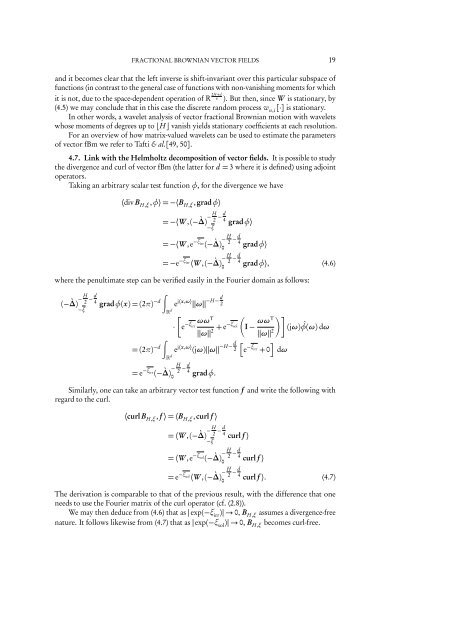FRACTIONAL BROWNIAN VECTOR FIELDS 1. Introduction. A one ...
FRACTIONAL BROWNIAN VECTOR FIELDS 1. Introduction. A one ...
FRACTIONAL BROWNIAN VECTOR FIELDS 1. Introduction. A one ...
Create successful ePaper yourself
Turn your PDF publications into a flip-book with our unique Google optimized e-Paper software.
<strong>FRACTIONAL</strong> <strong>BROWNIAN</strong> <strong>VECTOR</strong> <strong>FIELDS</strong> 19<br />
and it becomes clear that the left inverse is shift-invariant over this particular subspace of<br />
functions (in contrast to the general case of functions with non-vanishing moments for which<br />
it is not, due to the space-dependent operation of R 2H+d<br />
4 ). But then, since W is stationary, by<br />
(4.5) we may conclude that in this case the discrete random process w n,i [·] is stationary.<br />
In other words, a wavelet analysis of vector fractional Brownian motion with wavelets<br />
whose moments of degrees up to ⌊H⌋ vanish yields stationary coefficients at each resolution.<br />
For an overview of how matrix-valued wavelets can be used to estimate the parameters<br />
of vector fBm we refer to Tafti & al.[49, 50].<br />
4.7. Link with the Helmholtz decomposition of vector fields. It is possible to study<br />
the divergence and curl of vector fBm (the latter for d = 3 where it is defined) using adjoint<br />
operators.<br />
Taking an arbitrary scalar test function φ, for the divergence we have<br />
〈div B H,ξ ,φ〉 = −〈B H,ξ ,gradφ〉<br />
= −〈W ,(− `∆) − H 2 − d 4<br />
−ξ<br />
gradφ〉<br />
= −〈W ,e −ξ irr (− `∆)<br />
− H 2 − d 4<br />
0<br />
gradφ〉<br />
= −e −ξ irr 〈W ,(− `∆)<br />
− H 2 − d 4<br />
0<br />
gradφ〉, (4.6)<br />
where the penultimate step can be verified easily in the Fourier domain as follows:<br />
(− `∆) − H 2 − d 4<br />
−ξ<br />
gradφ(x) = (2π) −d ∫ d e j〈x,ω〉 ‖ω‖ −H− d 2<br />
<br />
<br />
· e −ξ ωω T<br />
irr<br />
‖ω‖ + 2 e−ξ sol<br />
I − ωωT<br />
(jω) ˆφ(ω) dω<br />
‖ω‖ 2<br />
= (2π)<br />
∫ −d e j〈x,ω〉 (jω)‖ω‖ −H− d <br />
2<br />
e −ξ irr + 0 dω<br />
d<br />
= e −ξ irr (− `∆)<br />
− H 2 − d 4<br />
0<br />
gradφ.<br />
Similarly, <strong>one</strong> can take an arbitrary vector test function f and write the following with<br />
regard to the curl.<br />
〈curl B H,ξ , f 〉 = 〈B H,ξ ,curl f 〉<br />
= 〈W ,(− `∆) − H 2 − d 4<br />
−ξ<br />
curl f 〉<br />
= 〈W ,e −ξ sol (− `∆)<br />
− H 2 − d 4<br />
0<br />
curl f 〉<br />
= e −ξ sol 〈W ,(− `∆)<br />
− H 2 − d 4<br />
0<br />
curl f 〉. (4.7)<br />
The derivation is comparable to that of the previous result, with the difference that <strong>one</strong><br />
needs to use the Fourier matrix of the curl operator (cf. (2.8)).<br />
We may then deduce from (4.6) that as |exp(−ξ irr )| → 0, B H,ξ assumes a divergence-free<br />
nature. It follows likewise from (4.7) that as |exp(−ξ sol )| → 0, B H,ξ becomes curl-free.
















